Science Highlights, February 2020
Awards and Recognition
Bioscience
First portable liquid nerve agent detector developed at Los Alamos
First sialic acid comparison across bird species lays groundwork for disease knowledge
Earth and Environmental Sciences
Advances in predictive CO2 sequestration: A robust and general framework
Intelligence and Space Research
OrganiCam: Most sensitive bio-organic survey tool could search for life on Mars
Awards and Recognition
Steinzig honored as American Society of Mechanical Engineers fellow
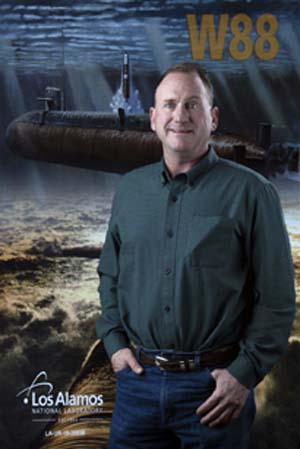
Mike Steinzig
Mike Steinzig, system engineer of LANL’s W88 Alteration and Refresh Program (Q-17), was honored as an American Society of Mechanical Engineers (ASME) fellow. The honor of fellow is bestowed on fewer than 3% of ASME members. Steinzig has been a corporate member of ASME for 21 years, as well as a leader of the Northern New Mexico Section.
Steinzig was recognized for his pioneering work in Electronic Speckle Pattern Interferometry (ESPI) for residual stress measurement. He was also recognized for his extensive contributions to ASME, the profession, and the community—mentoring students, funding scholarships, and supporting extracurricular educational opportunities for underserved local students.
Founded in 1880, ASME has grown to more than 100,000 members in more than 140 countries. It is known as the most globally recognized, trusted source of standards used around the world.
Technical contact: Mike Steinzig
Lebensohn selected as TMS 2020 speaker
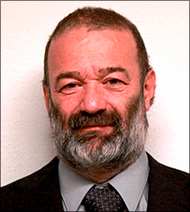
Ricardo Lebensohn
Ricardo Lebensohn of Fluid Dynamics and Solid Mechanics Group (T-3) was selected as a speaker for the 149th Annual Meeting and Exhibition of The Minerals, Metals & Materials Society (TMS). The meeting took place Feb. 23–27, 2020, in San Diego, Calif.. With nearly 14,000 members worldwide, TMS is a premier professional community for publication, accreditation, training, and professional development in the field.
Lebensohn’s talk was entitled “How Modelers Are Keeping Up with Emerging Materials Characterization and Data Analytics Techniques.” He highlighted the need for reduced-order models that represent a material’s mechanical behavior. He stated modelers need to be able to keep up with the in situ 3D characterization taking place in large experimental facilities.
Lebensohn is an expert in the structure–property relationship of materials and crystal plasticity modelling. He pioneered main-field viscoplastic self-consistent (VPSC) formulation and associated code, a homogenization-based simulation tool for the prediction of mechanical response and microstructure evolution of polycrystalline metals, minerals, and polymers. He also developed the specialization to polycrystals of the full-field Fast Fourier Transform (FFT)-based formulation and associated codes. In 2019, Lebensohn was honored with the TMS Structural Materials Division Distinguished Scientist/Engineer Award.
Technical contact: Ricardo Lebensohn
Enhancement in nuclear material container corrosion assessment receives Aoki Award

A variety of SAVY containers used for nuclear material storage.
Los Alamos researchers have made great strides in assessing corrosion damage in nuclear material storage containers, namely stainless steel Hagan and SAVY containers used for long-term storage. They presented their findings at the 2019 International Symposium on the Packaging and Transportation of Radioactive Materials (PATRAM), where their work received high praise and earned the researchers the 2019 Aoki Award for distinguished oral presentation.
PATRAM is considered the premier forum for exchange of information on radioactive material transport and storage issues, and the symposium offers significant contributions to the safe and secure transport of these materials.
Los Alamos is the design authority on the SAVY container for the National Nuclear Security Administration (NNSA). “Our goal was to examine the severity of surface erosion, pitting, and stress corrosion cracking to validate the design life of the container,” said Raj Vaidya, Weapons Production Directorate.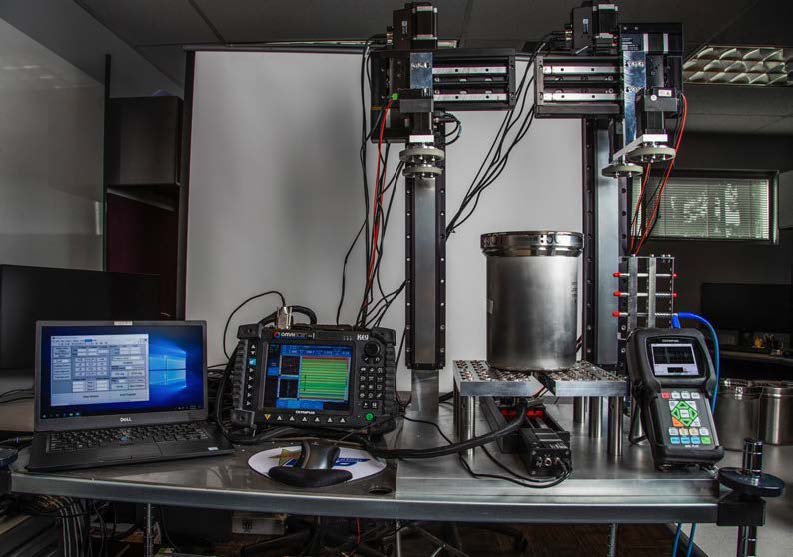
A view of the non-destructive corrosion testing setup, called “the MINTS” for Modular Integrated Non-destructive Test System.
First non-destructive test measuring in situ real-time corrosion
The Los Alamos researchers used ultrasonic testing (UT) and eddy current technology (ECA) to non-destructively peek inside the containers. Precise and repeatable corrosion measurements were made within 10 minutes. These measurements included wall thickness decrements and identification of pitting and damage on the inner surfaces of the containers.
The new methodology was compared to conventionally used contour measurement machine (CMM) methodology. It was determined that the non-destructive method can be used in lieu of CMM.
“We want to be able to say with certainty when a container needs to be removed from service. That requires understanding of key corrosion effects such as wall-thickness loss and pitting, which contribute to container degradation,” Vaidya said.
Automation and real-time improve safety
By the summer of 2020, the UT and ECA technique will be used in an automated container inspection system (MINTS, Modular Non-destructive Test System). The system will generate a real-time, color-coded corrosion plot for each nuclear material container. The system will be designed to accommodate a variety of container sizes, offering rapid inspection and flaw detection.
The system will have two specialized ECA probes: one flat probe to measure the bottom of the container and one curved probe to measure the edge of the container. The UT probe will be a multiplexed UT Sonopen system, which will accelerate field testing.
This automated system will reduce the amount of time workers need to be in radiation areas, increasing worker safety as well as surveillance cycle efficiency. This system will enable more frequent surveillance of at-risk containers, the creation of detailed records for each container, and long-term data collection for lifetime certifications.
Funding and mission
This research was funded by the LDRD Mission Foundations Research Program. The work supports the Laboratory’s Nuclear Deterrence and Global Security mission areas and the Science of Signatures capability pillar.
Reference: Rajendra Vaidya, Jonathan Gigax, Adrian Abeyta, Matthew Davenport. “Application of non-destructive testing to assess corrosion damage in nuclear material storage containers.” Proceedings of the 19th International Symposium on the Packaging and Transportation of Radioactive Materials PATRAM 2019, August 4–9, 2019, New Orleans, LA.
Technical contact: Raj VaidyaAnalytics, Intelligence and Technology
Zero-knowledge proofs securely verify neural networks
Michael Dixon, a cyber security research scientist, and his student, Zachary DeStefano, from the Advanced Research in Cyber Systems group (A-4) have laid the groundwork for employing zero-knowledge proofs (ZKP) toward national security and global security challenges. The premise of a zero-knowledge proof is to prove that a claim is true without revealing any additional information, such as the details as to why the claim is true.
“Zero-knowledge proofs provide exacting privacy controls over information while preserving integrity as a whole. This has the potential to change the verification game entirely by eliminating the reliance on trust,” said Dixon.
The researchers developed a prototype framework in C++ that augments the capabilities of neural networks to produce cryptographic zero-knowledge proofs. The ZKP successfully verified that the neural network was running correctly without revealing any sensitive model information in the process. The framework was demonstrated on a neural network trained to identify handwritten digits from the MNIST dataset.
Since the initial proof, the project has received further funding from the Information Science and Technology Institute (ISTI), extending the research into verifiable, privacy-preserving model training in distributed settings.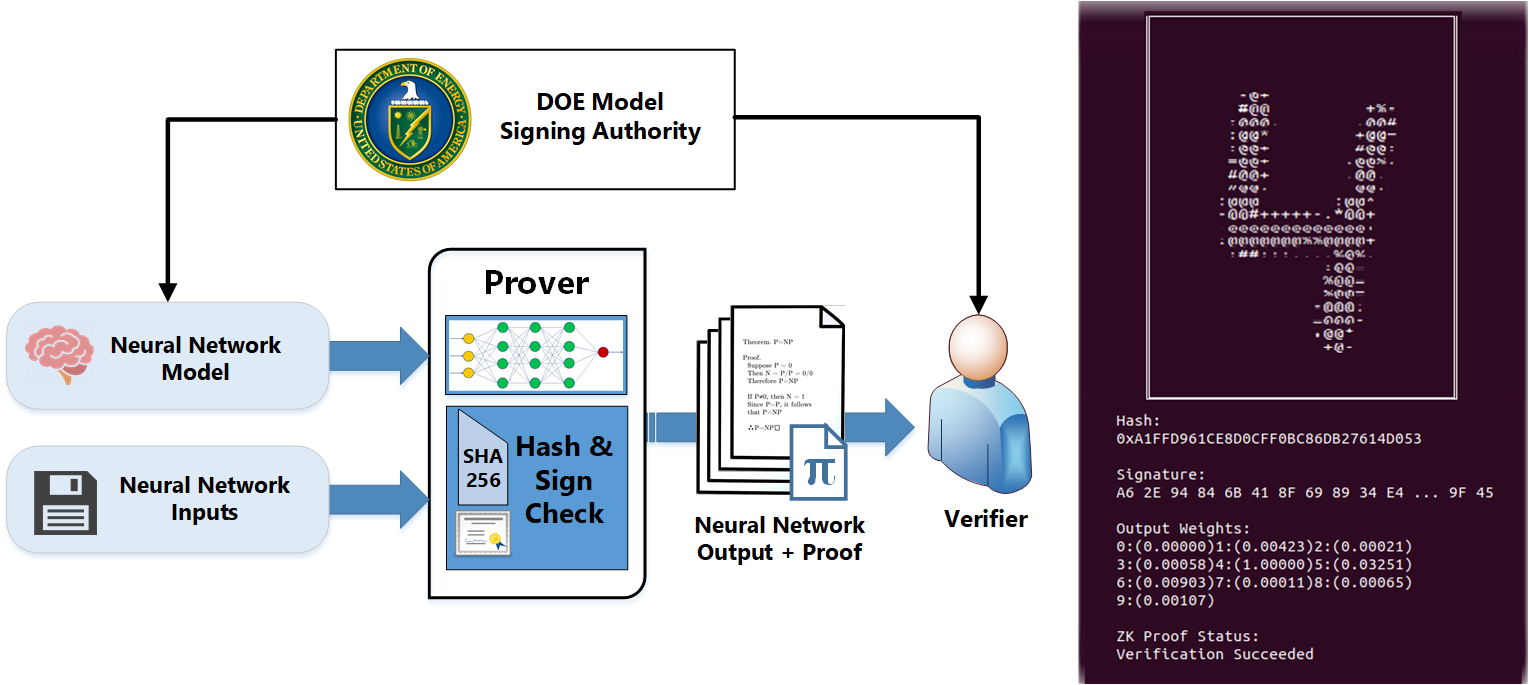
LANL scientists have demonstrated an end-to-end, provable verification system for neural networks that works without compromising sensitive training and model information.
ZKP for safeguards and national security
Zero-knowledge proofs can be applied to a variety of national security problems. They can be used to remotely verify processes and computations when sensitive details and specific information need to be safeguarded.
This idea becomes relevant to Los Alamos and the National Nuclear Security Association because suppliers, contractors, and outside parties are involved in processes. The ZKP methodology can be applied to treaty verification, operational cooperation, policy compliance, and weapons systems supply chains. This research can also be applied to privacy-preserving image and video verification solutions, which is becoming more and more relevant as the threat of adversarially generated media, or deepfakes, grows.
Ultimately, ZKPs can help expand capabilities by enabling robust verification whenever operational and strategic pursuits are constrained by the risk of compromising sensitive information.
Funding and mission
This research was initially funded by the National Security and Defense Program Office and received continued funding from ISTI. This work supports the Laboratory’s Nuclear Deterrence and Global Security mission areas and the Integrating Information, Science & Technology for Prediction capability pillar.
Technical contact: Michael DixonBioscience
First portable liquid nerve agent detector developed at Los Alamos
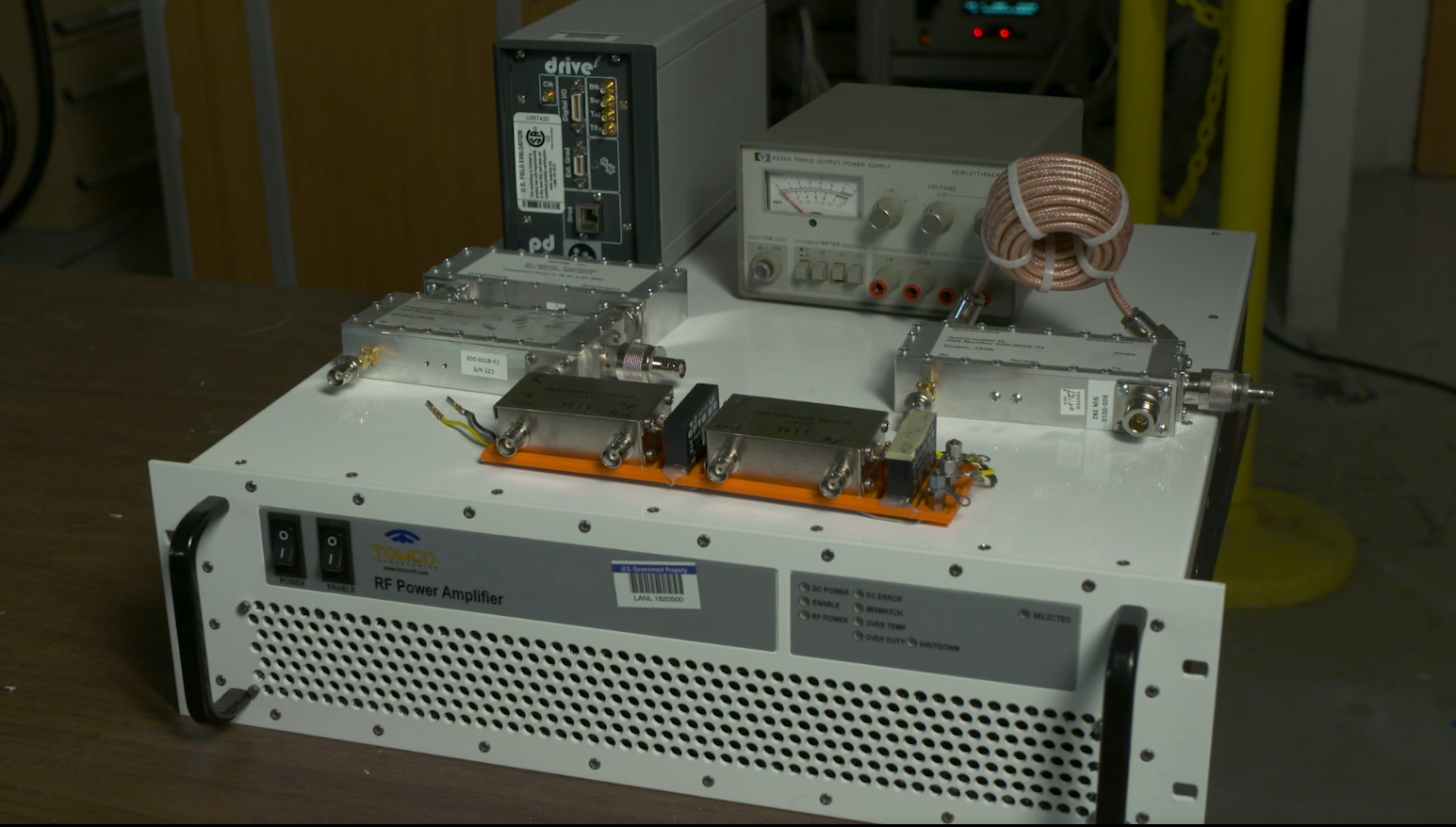
Part of the demo unit nerve agent detector. The final system will be small, portable, and easy to use.
Airport security forever changed after the terrorist attacks of 9/11. Although many improvements have been made to ensure safety, the Department of Homeland Security (DHS) remains concerned about nerve agents: chemicals that affect the nervous system.
These chemicals are highly dangerous and difficult to detect, especially in fast-paced sampling environments such as an airport. That’s why the DHS supported a team of Los Alamos bioscientists in developing the first liquid nerve agent detector that is both reliable and portable.
“One key feature of our device is that it can screen through typical containers, such as plastic bottles, to detect for nerve agents,” said Jacob Yoder of Bioenergy and Biome Sciences (B-11).
Eight seconds to result
The Los Alamos researchers successfully created a portable liquid nerve agent detector that airports can use to test passenger bottles for nerve agents without opening the cap of the bottle. Their technology, which employs nuclear magnetic resonance at low magnetic field, is extremely reliable, removing the false-positive and false-negative results. This is because their technology is specifically looking for three nuclei distinctive of nerve agents: hydrogen, phosphorus, and fluorine.
“The nerve agent fingerprint is so specific “that false positives with our device are extremely rare,” said Bob Williams, lead investigator (B-11).
It only takes eight seconds to get a result of “benign,” “a threat,” or a “potential threat,” and it’s an extremely sensitive technique.
The detector was designed to be simple, so any Transportation Security Administration (TSA) employee can operate it. A bottle (for example, a tube of sunscreen) goes into the detector, gets evaluated, and comes back out with a result. It is a critical part of the design that the bottle does not need to be opened at any point, as exposure would compromise safety.
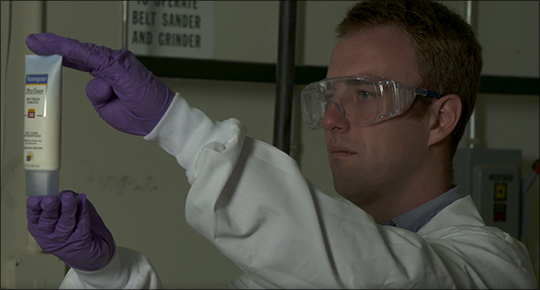
Bioscientist Derrick Kaseman holds an example bottle of sunscreen that can be accurately screened for nerve agent with the Los Alamos-developed system.
The only portable detector of its kind
There are other technologies that can detect nerve agents, but none are portable. Portability is a necessary characteristic for airport security, but it’s a challenging design parameter to accommodate. Most techniques use a high magnetic field, which requires cryogenic liquids, making these units cumbersome and impractical for TSA.
The LANL-developed detector, however, is able to use a low magnetic field via a 300 millitesla permanent magnet array. This removes the need for cryogens, allowing for a reduced size. This unit operates on standard 120-V power or even a battery.
Although the detector is targeting nerve agents right now, it can be designed to detect other chemicals of interest, such as liquid explosives. It can also be employed for border and port security.
Funding and mission
This research was funded by the Department of Homeland Security, Science and Technology Department. The work supports the Laboratory’s Global Security mission area and the Science of Signatures capability pillar.
Reference: Williams RF, Espy MA, Janicke MT, Michalczyk R, Schmidt JG, Yoder JL, Erkkila TH, Magnelind PE, Nath P, Urbaitis AV, Widgeon S, and Kaseman D: A Low to Ultra-Low Magnetic Field Nuclear Magnetic Resonance Instrument for Detecting Chemical Nerve Agents. U.S. Patent 62/812,412, March 1, 2019.
Technical contact: Bob Williams and Jacob Yoder
First sialic acid comparison across bird species lays groundwork for disease knowledge
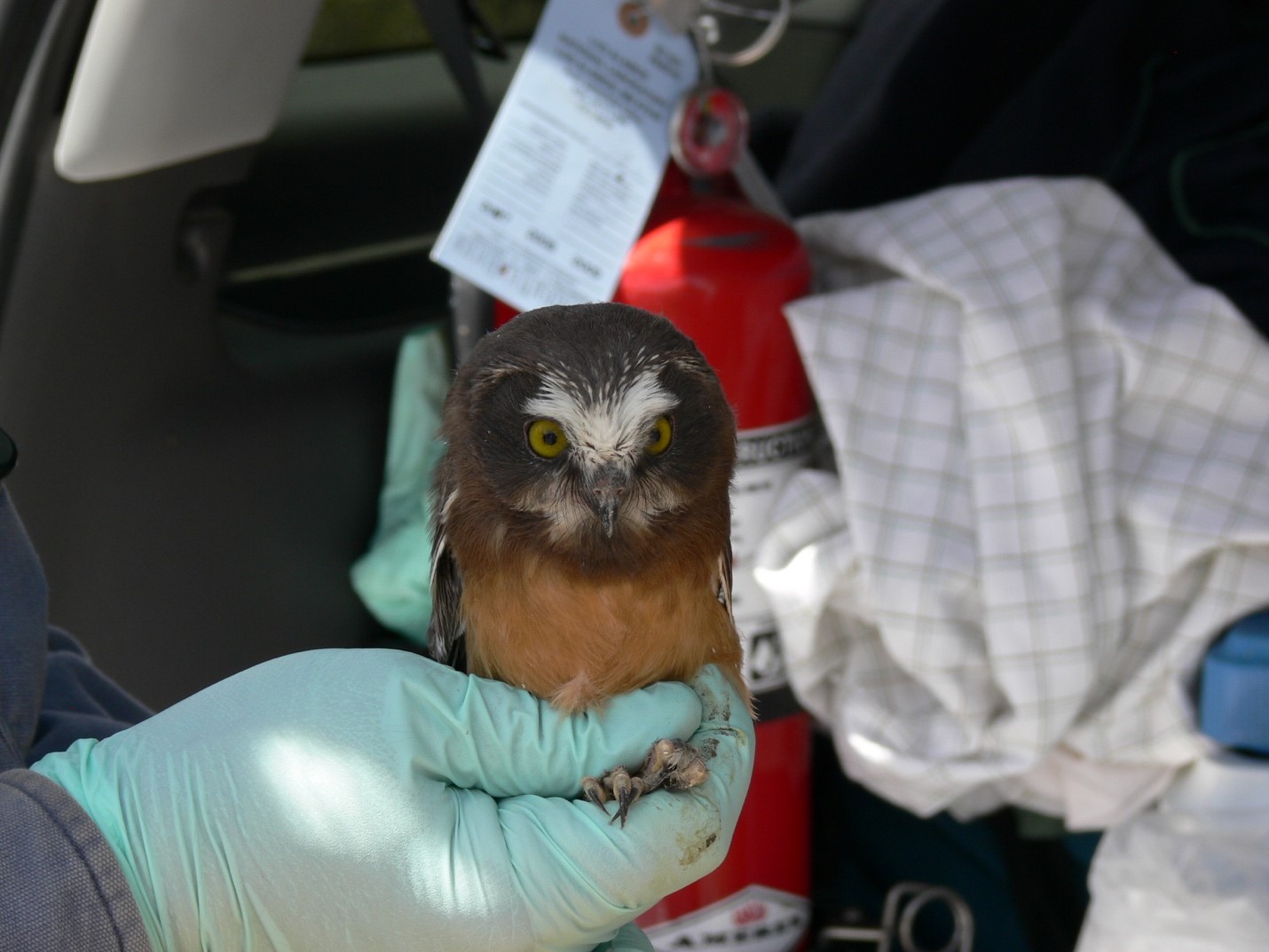
The researchers sampled both captive and wild birds to compare sialic acid results.
Los Alamos bioscientists recently filled a knowledge gap with respect to baseline variation of an important molecule, called sialic acid, in birds (Class Aves). Sialic acid is a cell surface sugar involved in physiological and pathogen recognition processes, not just in birds but in many species, including humans. It is not unusual for diseases to jump from wildlife to humans, such as the current coronavirus from China; therefore, monitoring disease susceptibility in animal hosts is critical to global security.
The LANL bioscientists recorded sialic acid quantity and glycosidic linkage (sialic acid bound to galactose) in 76 bird species. It was the first study to compare sialic acid data across a taxon. The bioscientists determined sialic acid can be used as a signature in phylogenetic groups and can help determine which species are more susceptible to disease. As such, these data will lay the groundwork for future disease research.

Class Aves species were sampled in this research.
Sialic acid variations alter species susceptibility
There are many different versions of sialic acid, and these variations can impact how susceptible an individual may be to a particular disease, such as malaria or influenza. Understanding sialic acid can have wide-ranging implications for biomedicine, disease ecology, and environmental protection. The data from this study will help produce higher-performing epidemiological models.
The bioscientists developed a new methodology for this study that combined mass spectrometry and stable isotopes. They were able to compile a data matrix for birds that expands the previous knowledge base in the field focused on mammals. This will enable large comparison studies.
Funding and mission
This work was supported by a Los Alamos Laboratory Directed Research and Development (LDRD) award. The research supports the Laboratory’s Global Security mission area and the Science of Signatures capability pillar.
Reference: Mark D. Jankowski, Scott R. Glaberman (U. of South Alabama), David B. Kimball, Kirsten J. Taylor-McCabe, Jeanne M. Fair. “Sialic acid on avian erythrocytes.” Comparative Biochemistry and Physiology Part B: Biochemistry and Molecular Biology. Volume 238, December 2019, 110336. https://doi.org/10.1016/j.cbpb.2019.110336
Technical contact: Mark Jankowski
Chemistry
Kozimor lends expertise for special f-element chelation issue of Inorganic Chemistry
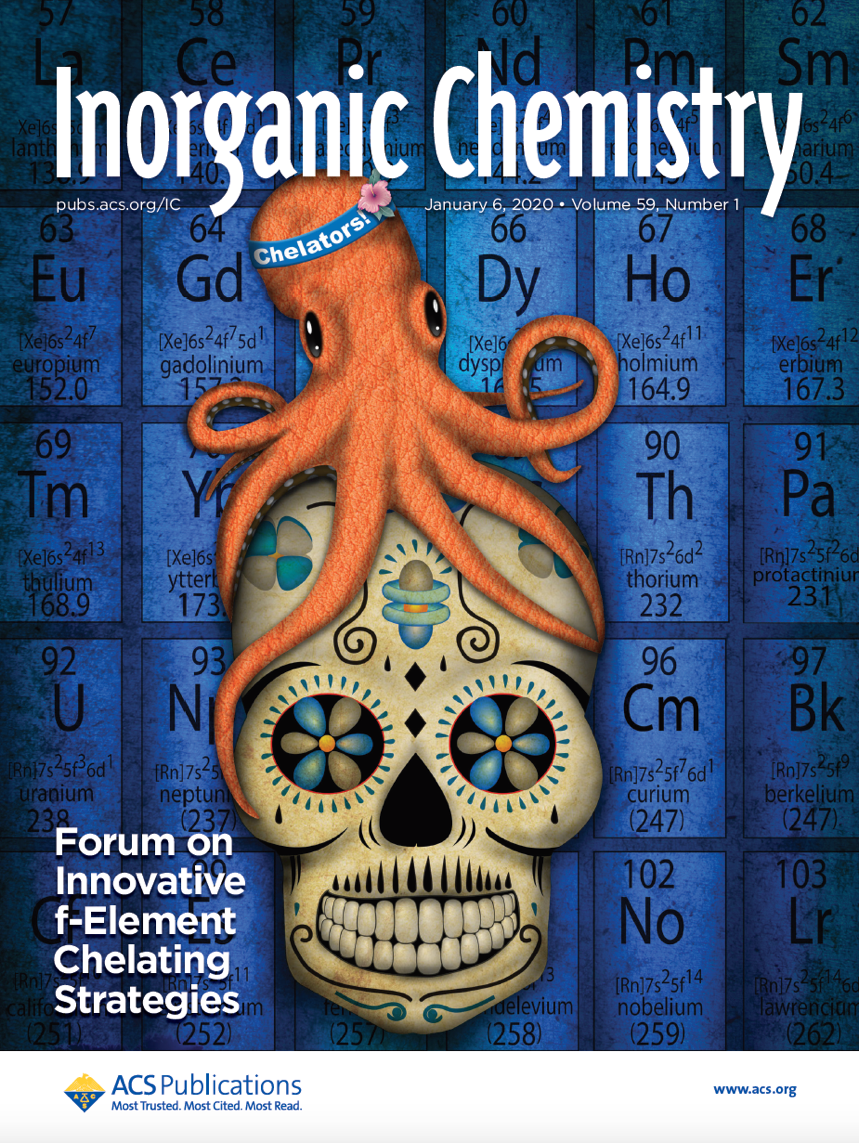
The cover highlights that ideal f-element chelators (represented by an eight-limbed octopus) need to fulfill the large coordination numbers of these metals, typically eight and above. (Cover art by Josh Smith, Los Alamos National Laboratory)
Stosh Kozimor of the Inorganic, Actinide, and Analytical Chemistry group (C-IIAC) at Los Alamos was selected to co-edit with Rebecca Abergel of UC Berkeley the Jan. 6 special issue of the American Chemical Society’s publication Inorganic Chemistry. This issue dove into innovative f-element chelating strategies that are transforming the field.
The cover art was created by Josh Smith of LANL’s Chemical, Earth, and Life Sciences Associate Lab Directorate. The eight-limbed octopus is representative of the need for a chelator capable of binding an f-element metal with eight (or more) sites.
From medical applications to energy security
Lanthanides and actinides are f-block elements—possessing electrons in f-orbitals. Where electrons reside in reference to the nucleus impacts an element’s reactivity and behavior. Plutonium is one of the best-known f-elements, and it is an excellent example of the complex chemistry that can come with these elements.
Chelators are organic molecules that bind metals. Chelating lanthanides and actinides is important for many things relevant to everyday life, such as magnetic resonance imaging, radioisotope treatment delivery, and separations chemistry for nuclear fuel.
Each article in the special issue contributes a significant advancement in the field of f-element chelation. Fundamental understanding of lanthanide and actinide chelation chemistry is still unfolding, and this issue serves as a reference for researchers aiming to solve existing and emerging technical challenges within f-element science.
“These contributions show a clear need to better define fundamental parameters that influence the poorly understood f-element properties,” Kozimor said.
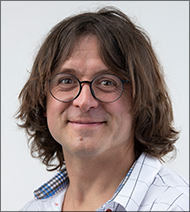
Stosh Kozimor currently leads fundamental chemistry studies of heavy elements and isotope production at LANL.
Extensions of LANL’s expertise
Los Alamos is the U.S. Plutonium Center of Excellence, but it is also home to the Seaborg Institute as well as actinide research and development. Kozimor has worked with f-elements at LANL since 2006, when he was mentored by Carol Burns and Dave Clark. He currently leads fundamental chemistry studies of heavy elements and isotope production.
Understanding f-element chelation chemistry directly relates to national security challenges and LANL’s mission. Chelation strategies provide a foundation for separations in analytical chemistry to certify actinide metals across the U.S. Department of Energy complex and support reprocessing technologies of spent nuclear fuel currently deployed in many countries around the world.
Funding and mission
This work supports the Laboratory’s Energy Security mission area and the Nuclear and Particle Futures capability pillar.
Reference: Stosh Kozimor and Rebecca Abergel (University of Berkeley). “Innovative f‑Element Chelating Strategies,” Inorganic Chemistry. Inorg. Chem. 2020, 59, 4−7. DOI: 10.1021/acs.inorgchem.9b03583.
Technical contact: Stosh KozimorEarth and Environmental Sciences
Advances in predictive CO2 sequestration: A robust and general framework
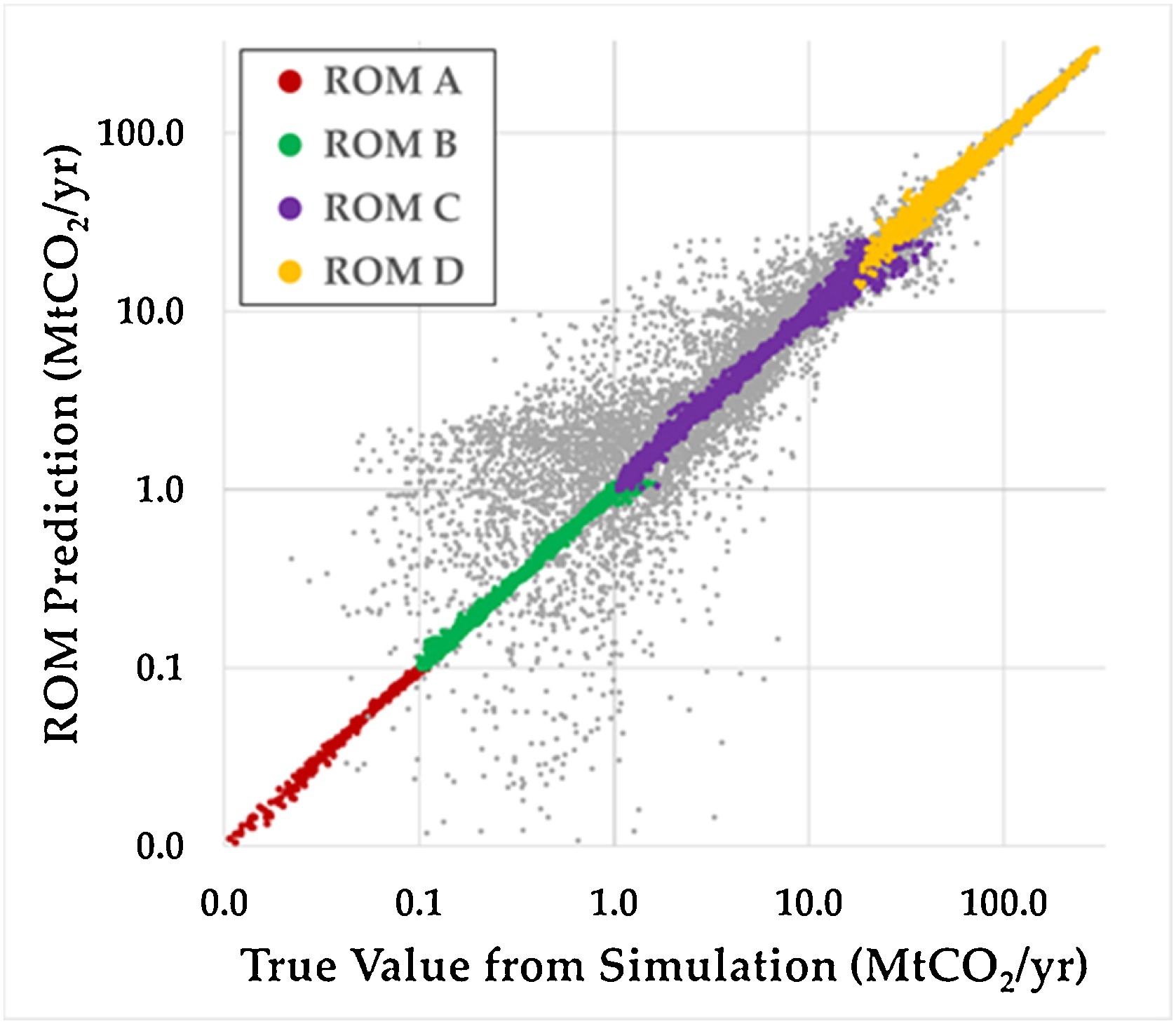
The performance of combining sub-ROMs (ROMs A, B, C, and D) generated from ROMster framework. The gray points correspond to the performance of ROM generated from traditional approach (e.g., single ROM approach).
Los Alamos researchers in Earth and Environmental Sciences made strides in reduced-order models (ROMs). They found that canonical ROMs can display excellent overall statistics yet offer poor predictive power. ROMs are critical tools for optimization, sensitivity analysis, model calibration, and uncertainty quantification where full-order models cannot be feasibly executed many times. In particular, ROMs are a powerful approach to CO2 sequestration.
These researchers identified the shortcomings of traditional ROMs and introduced a novel ROM approach, based on a set of sub-ROMs.
ROMster framework reduces error from 200% to 4%
The novel ROM approach was dubbed the ROMster framework. Unlike traditional ROMs that use a single model for each simulated response (e.g., CO2 injection rates, CO2/brine leakage rates), the ROMster uses a set of sub-ROMs.
As an example, the researchers showed that a traditional statistically high-performing carbon sequestration ROM (coefficient of determination R2 of 0.99) can have average absolute relative errors of over 200%. The ROMster framework, however, reduced the average error from 200% to only 4% in their case study. It was shown to be a robust and general framework that addresses the pitfalls of traditional ROMs.
It is believed that many researchers in GCS, hydrology, petroleum, and other communities have not realized the potential pitfall in ROM generation and thus the ROMster framework will provide a powerful approach for future ROM development.
Funding and mission
This work was funded by the U.S. DOE’s Fossil Energy Office through the National Risk Assessment Partnership and Southwest Regional Partnership on Carbon Sequestration. The work supports the Laboratory’s Energy Security mission area and the Integrating Information, Science, and Technology for Prediction capability pillar.
Reference: Bailian Chen, Dylan R. Harp, Rajesh J. Pawar, Philip H. Stauffer, Hari S. Viswanathan, and Richard S. Middleton. “Frankenstein’s ROMster: Avoiding Potential Pitfalls in Reduced-order Model Development,” International Journal of Greenhouse Gas Control, 93, Article No. 102892, 2020. https://doi.org/10.1016/j.ijggc.2019.102892
Technical contact: Richard Middleton
Intelligence and Space Research
OrganiCam: Most sensitive bio-organic survey tool could search for life on Mars
Los Alamos researchers and collaborators have developed a first-of-its-kind instrument for detecting biomolecules in extreme environments, such as in outer space or high radiation. OrganiCam can be used for assessment after a nuclear reactor accident or contaminant detection in medical facilities — but its most exciting role could be in detecting organic material, or life, on Mars or Europa.
OrganiCam is the first lightweight instrument built for space that uses time-resolved fluorescence imaging for organics. It is incredibly sensitive—detecting in the parts-per-billion range—but it can distinguish between mineral fluorescence and biofluorescence using its gated detector that exposes the camera at a speed of 100 nanoseconds. It will quickly scan an area and deliver both a fluorescence image and Raman spectral information.

Cross-sectional view of OrganiCam.
The researchers who developed OrganiCam used heritage knowledge and hardware designs from their previous space instruments ChemCam and SuperCam. (ChemCam is currently on the Mars Rover exploring the Red Planet, and SuperCam is planned for this year's Mars mission.) Added to that knowledge is a great deal of innovation for OrganiCam, including its unique fast fluorescence imaging, ultra-radiation-hardened lenses, and a lighter and more compact design.
The aim is to send OrganiCam on a future mission to Mars or the surface of ice-covered Europa, one of Jupiter’s moons.
Mars life is more likely underground

A Mars skylight cave. The opening is 150 meters across and > 170 meters deep. OrganiCam is built to go inside a cave like this one and look for life beneath the surface. Photo credit: NASA/JPL
The target for OrganiCam is not just the surface of a planet or moon, but also to take OrganiCam underground. The surface of Mars is not very hospitable given the cold and radiation. However, underground there is more likely to be detectable organic material. The easiest access would be through lava-tube caves on Mars.
“Going into a cave underground on Mars is essentially the Holy Grail,” said Roger Wiens, lead investigator.
The challenge is getting instrumentation down there. OrganiCam was designed to be lightweight and small, so it can travel into a cave via a drone. Once there, it would survey the environment for signs of life, or biomolecules.
A fundamental innovation
The fundamental innovation of OrganiCam is the time-dependent signature.
“There are many different minerals on Mars, and it is challenging to tell them apart from the organics that might be there,” said Patrick Gasda of Space and Remote Sensing (ISR-2).
The OrganiCam technology will do that, offering a large picture of organic presences, where images give the context of organic detection. From this information, more targeted samples can be taken. OrganiCam’s ability to perform two important and very different types of analysis using a single instrument is a significant advantage—especially with OrganiCam’s compact instrument.
Funding and mission
This research was funded by a LANL Laboratory Directed Research and Development award. Los Alamos collaborated with the University of Hawaii, L'Institut de Recherche en Astrophysique et Planétologie, and the Centre National d'Etudes Spatiales. The work supports the Laboratory’s Global Security mission area and the Science of Signatures capability pillar.
Technical contact: Roger Wiens and Benigno Sandoval
X-Computational Physics
Improved contaminant estimates in inertial confinement fusion
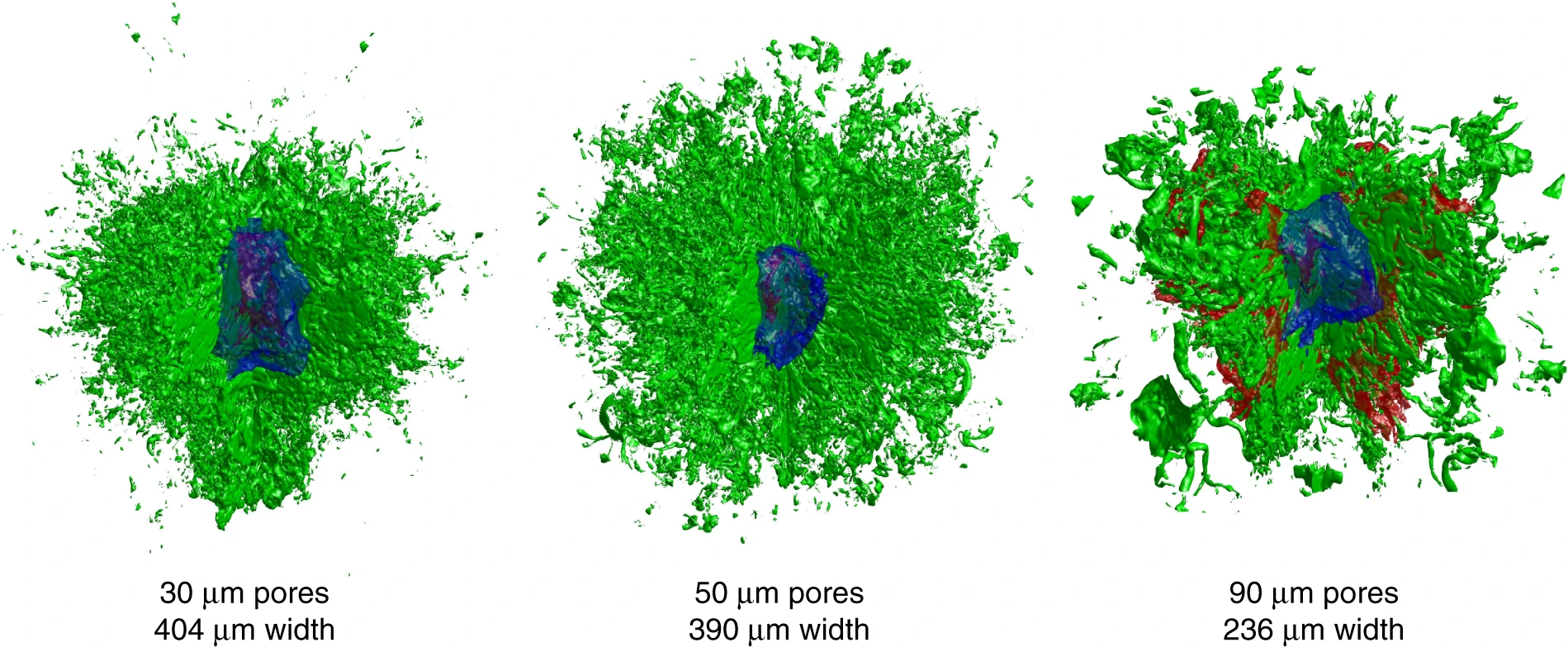
Visualizations of the shock (red), pore interfaces (green), and hot-spot boundary (blue) at bang time for the three different initial pore sizes. A quadrant has been cut out of the shock and pore data in order to aid in the observation of internal features.
Inertial confinement fusion (ICF) involves the compression of capsules containing deuterium and tritium, with the goal of achieving self-sustaining thermonuclear burn. A recent study performed as part of the MARBLE project by Los Alamos researchers and University of Rochester collaborators published in Nature Communications reports novel separated reactant experiments and simulations that significantly improve our understanding of factors that degrade implosion performance.
Their results indicate that the amount of contaminant mass in the hot spots of high-yield implosions is routinely underestimated. Traditional methods for estimating this mass assume thermal equilibrium between contaminant and fuel, but this is not the case.
Simulation and experimental differences indicated an issue
The injection of contaminant mass into capsule fuel regions is known to degrade the performance of capsule implosions. Nevertheless, little is known about how contaminant is distributed in the fuel region, and hence, how it affects fusion reactions as well as how quickly it absorbs energy from hot fuel. That’s why the LANL researchers and University of Rochester collaborators designed novel experiments to investigate.
Specifically, they investigated how quickly the contaminant mixes with hot fuel and how quickly these materials come into thermal equilibrium. Simulations were performed using LANL’s xRAGE radiation-hydrodynamics code, and experiments were performed at the University of Rochester’s OMEGA laser facility.
They observed persistent chunks of contaminant that did not achieve thermal equilibrium with the fuel throughout the burn phase, thus nullifying traditional theory. They noted that, as a consequence, established methods for calculating the amount of contaminant in implosions underestimated this amount by a factor of two or more.
This knowledge can be used to improve ICF performance by decreasing the magnitude of capsule asymmetries or adjusting designs to make them more robust to hydrodynamic instabilities.
Funding and mission
This research was funded by Campaigns 1 and 4 in the Office of Experimental Sciences. The work supports the Laboratory’s Energy Security mission area and the Science of Signatures and the Nuclear and Particle Futures capability pillars.
Reference: Brian M. Haines, R. C. Shah (University of Rochester), J. M. Smidt, B. J. Albright, T. Cardenas, M. R. Douglas, C. Forrest, V. Yu Glebov, M. A. Gunderson, C. E. Hamilton, K. C. Henderson, Y. Kim, M. N. Lee, T. J. Murphy, J. A. Oertel, R. E. Olson, B. M. Patterson, R. B. Randolph, D. W. Schmidt. “Observation of persistent species temperature separation in inertial confinement fusion mixtures.” Nat. Commun. 11, 544 (2020). DOI: https://doi.org/10.1038/s41467-020-14412-y
Technical contact: Brian Haines








